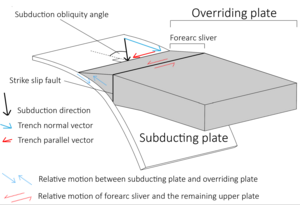
Oblique subduction is a form of subduction (i.e. a tectonic process involving the convergence of two plates where the denser plate descends into Earth's interior) for which the convergence direction differs from 90° to the plate boundary. Most convergent boundaries involve oblique subduction, particularly in the Ring of Fire including the Ryukyu, Aleutian, Central America and Chile subduction zones. In general, the obliquity angle is between 15° and 30°. Subduction zones with high obliquity angles include Sunda trench (ca. 60°) and Ryukyu arc (ca. 50°).
Obliquity in plate convergence causes differences in dipping angle and subduction velocity along the plate boundary. Tectonic processes including slab roll-back, trench retreat (i.e. a tectonic response to the process of slab roll-back that moves the trench seaward) and slab fold (i.e. buckling of subducting slab due to phase transition) may also occur.
Moreover, collision of two plates leads to strike slip deformation of the forearc, thus forming a series of features including forearc slivers and strike slip fault systems that are sub-parallel to ocean trenches. In addition, oblique subduction is associated with the closure of ancient ocean, tsunami and block rotations in several regions.
Deformation features
Forearc slivers
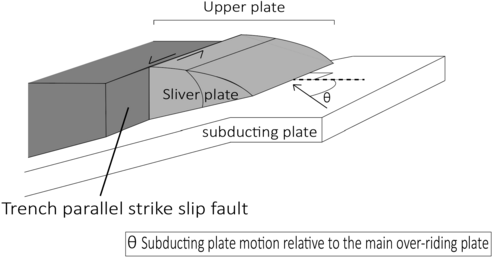
Forearc slivers are partly detached continental blocks of the overriding plates. They are bounded by the trenches and trench parallel strike slip fault systems. The motion of forearc slivers depend on the obliquity of the subducting slabs.
Moreover, some forearc slivers occur in the absence of well defined strike-slip fault systems, and sliver motions are not purely strike-slip.
Trench parallel strike-slip fault systems
Trench parallel strike-slip faults are deformational products contributed by trench parallel component of strain partitioning. They are located between the forearc slivers and the remaining overriding plates.
| Fault | Subducting plate | Overriding plate | Strike slip motion | Motion rate |
|---|---|---|---|---|
| Philippine Fault | Philippine Sea Plate | Sunda Plate | Left-lateral motion | 20–25 mm per year |
| Japan Median Tectonic Line | Philippine Sea Plate | Eurasian Plate | Right-lateral motion | 5 mm per year |
| Liquiñe-Ofqui Fault | Nazca Plate | South American Plate | Right-lateral motion | 6.8–28 mm per year |
Orientation of strike slip faults
Vertical strike slip fault systems are generally accepted by the early literature of oblique subduction. However, modern technology, such as seismic profiling, reveals that the faults are not necessarily vertical. Several other models concerning the orientations of the faults are proposed.
| Hypothetical models | Figures | Description |
|---|---|---|
| Vertical fault model |  |
During oblique subduction, the convergence and coupling between two plates create horizontal shear stress on the overriding plate. Early studies suggested that horizontal shear is likely to concentrate in vertical planes. Together with the field measurements on seismicity. The trench parallel strike slip fault is thought to be vertical from earth surface down to the subducting plate. |
Mega-splay fault system model |
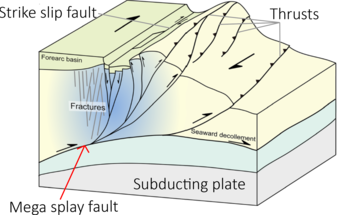 |
In Nankai Trough (Formed by oblique subduction of the Philippine Sea Plate), seismic profiles reveal that the margin parallel strike slip fault and thrust structures are linked by the mega splay fault system, which align in a parallel manner with the subducting plate (i.e. Philippine Sea Plate). |
| Curved fault model | 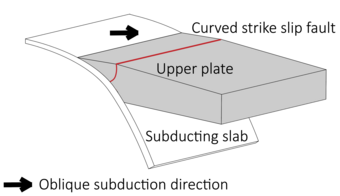 |
The Liquiñe-Ofqui Fault is a trench parallel dextral strike-slip fault in Andes. Based on analysis on shear stress distribution, Ormeño et al., (2017) suggested that it is a curving strike slip fault. The hypothetical geometry coincides with an curving reflector obtained in the seismic reflection profile of the subduction zone. |
Slip accommodating mechanisms
Trench parallel slip component from oblique subduction may not be fully accommodated by the aforementioned trench parallel strike slip faults. Several models suggest that there are other slip accommodating mechanisms formed by oblique subduction as means to take up the remaining slip component.

Margin parallel strike-slip faults in subducting plates
See also: 2012 Indian Ocean earthquakes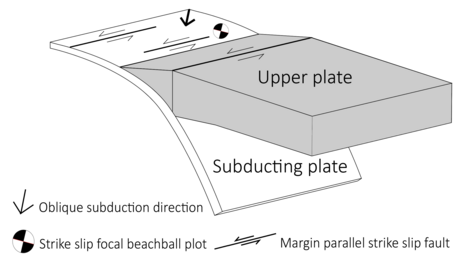
Ishii et al., (2013) suggested that the trench parallel strike-slip faults may appear in the obliquely subducting slabs to accommodate a portion of the trench parallel slip component.
In the Sumatra subduction zone, the trench parallel slip component is measured to be approximately 45 mm per year, the motion rate of northern Great Sumatra Fault ranges from 1 to 9 mm per year with the maximum rate of 13 mm per year. The result shows that the trench parallel slip component of at least 32 mm per year is left.
On 11 April 2012, a Mw 8.6 earthquake occurred in the subducting plate (i.e. the Indo-Australian Plate). Strike-slip seismicity was recorded in the earthquake. This infers strike slip fault systems are present in the descending slab and they may potentially accommodate slip component from oblique subduction.
| Location of faults | Features |
|---|---|
| Upper plate |
|
| Subducting plate |
|
Strain partitioning
Main article: Strain partitioningStrain partitioning is a form of deformation. In oblique subduction zone, strain partitioning is initiated into trench parallel component and trench normal component. The trench parallel component is accommodated by localized shear zones (short-term deformation) or trench parallel strike slip fault systems (long-term deformation) in the overriding plates. Likewise, this component commonly leads to the formation of forearc slivers. The trench normal component is taken up by thrust structures. These thrusts are generally discontinuous and their geometries change progressively.
Short-term deformation: Localized shear zone

Short-term deformation is mainly elastic and acts at human time scale (i.e. perceptible during a human lifetime, unlike changes that take place on a geologic time scale). When the denser plate subducts beneath the upper plate, they are coupled at the interface (i.e. plate coupling). The process of plate coupling thus generates tectonic force that follows the subduction direction.
The orientation of tectonic force gradually rotates toward the trench normal direction. This attributes to the decline of trench parallel component when the force leaves the plate coupling zone. In this way, only the frontal part, rather than the whole upper plate, is dragged by the subducting slab.
Long-term deformation: Formation of forearc sliver and strike slip fault
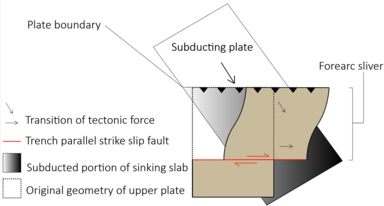
Long-term deformation occurs at geological time scale. Under continuous oblique subduction, the aforementioned frontal part of the upper plate permanently accommodates the trench parallel component. In this way, the orientation of tectonic force rotates gradually toward the trench parallel direction.
Strong and continuing tectonic force in trench parallel direction leads to the development of trench parallel strike slip fault system. The fault thus separate a portion of the forearc from the overriding plate, forming the forearc sliver.
Tectonic events related to oblique subduction

The 1771 Great Yaeyama Tsunami
Main article: 1771 Great Yaeyama TsunamiThe tsunami occurred in the southwestern part of the Ryukyu arc. Yukinobu et al., (2018) suggested that oblique subduction was the primary reason leading to the occurrence of the tsunami.
| Subduction velocity | 50 to 63 mm per year |
| Subduction direction | N60°W to N50°W |
| Subduction obliquity angle | 40° to 60° |
Tectonic setting
In the plate boundary, an approximately 80 km long and 30 km wide depression is observed. It obscures trench parallel strike slip fault and the topographic ridge of the wedge.
Oblique subduction and tsunami

Block rotation

Oblique subduction has led to rotation of microblocks about nearby poles of rotation (See also: Euler poles) in some oblique subduction zones. In these regions, the trench parallel strike slip fault systems are less prominent. This is because a portion of the trench parallel component is accommodated by the microblock rotation.
Examples of oblique subduction-induced block rotation are identified in North Island, Cascadia and New Guinea.
Example: North Island oblique subduction zone
See also: Hikurangi TroughTectonic setting
The North Island oblique subduction zone in New Zealand was established by the obliquely subducting Pacific Plate beneath the Indo-Australian Plate. A trench parallel strike slip fault system, North Island Dextral Fault Belt, was formed. Based on geological and geodetic data, five tectonic blocks are identified in the region. These blocks are separated by block-bounding faults.
Microblock rotation
Based on GPS measurement, a clockwise rotation of microblocks at a rate of 0.5° to 3.8° per million year relative to the Indo-Australian Plate is observed. This caused tectonic extension in Taupo Volcanic Zone and tectonic shortening in northwestern South Island, for example the Buller region.
In addition, the block rotation accommodates 25% to 65% of the trench parallel component from oblique subduction. Therefore, high rate trench parallel strike slip faults are absent in the North Island.
Rotation mechanism
In the oblique subduction zone, the sinking slab is characterized by the Hikurangi plateau in the south. The thickness of this oceanic plateau ranges from 15 km to 10 km along the oceanic trench. The along strike thickness variation leads to differential subduction rate. In the southern trench, thick oceanic plateau induces high collisional resistance forces that cripples the subduction process. However, the thin oceanic crust in the north is subducted. This activated the tectonic block rotations about a nearby axis.
Closure of Northeastern Paleo-Tethys Ocean
See also: Paleo-Tethys OceanGeological setting
The Qinling-Dabieshan orogen in central China consists of three separate plates, including the north China plate, the Qinling-Dabieshan microplate, and the south China plate. Geological and geochemical analysis suggest that there was an ocean basin between the plates and it was part of the Paleo-Tethys Ocean
Evidence of oblique subduction
Tectonic features of oblique subduction, for example a right lateral strike-slip thrust belt are identified in the tectonic zone. These evidence suggest that the south China plate was obliquely subducted to the northwest beneath the north China plate in the Early Mesozoic and led to the closure of the northeastern Paleo-Tethys Ocean.
Example of oblique subduction
Peru-Chile trench
Main article: Peru–Chile TrenchThe Peru–Chile Trench is part of the Andean oblique subduction zone that was formed as a result of oblique subduction between the sinking Nazca Plate and the South American Plate. The current subduction direction is at east-north-east (see the summary below). However, geological record shows southeast subduction direction in Late Cretaceous period.
| Subduction velocity | 66 mm per year |
| Subduction direction | N78°E |
| Subduction obliquity angle | Range from 22° to 32° |
Margin parallel strike slip faults

Four major trench parallel strike slip faults are identified in the oblique subduction zone. Liquiñe-Ofqui Fault is a 1,200 km long fault that located in the southern Andes. Left lateral strike slip motion was active during Mesozoic period. In Pliocene period, strike slip motion of the fault system changed to right lateral motion to accommodate the trench parallel slip component from oblique subduction.
The El Tigre Fault is observed in the central part of the subduction zone. It is a relatively short strike slip fault (ca. 120 km) that located further landward. The slip rate of the fault system is approximately 1 mm per year.
The Atacama Fault and the Precordilleran Fault are located in northern Chile. The Atacama Fault extends more than 1,000 km. It was formed during the Mid to Late Jurassic period as a left-lateral fault due to oblique subduction of the Phoenix Plate. The fault system has been inactive since the Miocene Period. The right lateral slip rate is estimated to be less than 1 mm per year since the Pliocene.
The Precordilleran Fault, also known as the Domeyko fault, is composed of several anastomosing faults (i.e. branching and irregular faults) including Sierra Moreno Fault, West Fault and Limon Verde. Precordilleran Fault was formed in the Late Eocene. In Neogene period, the fault system changed from left lateral to right lateral motion along with the uplift of the Precordillera.
Forearc sliver

Two major forearc slivers are observed along the Peru-Chile Trench. The Peruvian Sliver, also known as Inca Sliver, has a width of 300 to 400 km and a total length of over 1,500 km. It extends from the Gulf of Guayaquil in the north to the Altiplano in the south. The continental boundary is located between the Western Cordillera and the Eastern Cordillera.
Chiloe Microplate, also known as Chiloe Block, is a forearc sliver that detached along the Liquine Ofqui Fault. It is bounded by Arauco Peninsula and Chile Triple Junction. The sliver moves northward with a motion rate ranges from 32 mm per year in the south to 13 mm per year in the north. This northward motion not only caused by the oblique subduction of the Nazca Plate, but also the oblique collision and spreading of the Chile Rise at the southern edge of the sliver.
See also
References
- ^ Westbrook, G. K. (2005-01-01), "TECTONICS | Convergent Plate Boundaries and Accretionary Wedges", in Selley, Richard C.; Cocks, L. Robin M.; Plimer, Ian R. (eds.), Encyclopedia of Geology, Oxford: Elsevier, pp. 307–317, doi:10.1016/b0-12-369396-9/00456-1, ISBN 978-0-12-369396-9, retrieved 2021-11-11
- Introduction to Mineralogy and Petrology. 2020. doi:10.1016/c2019-0-00625-5. ISBN 9780128205853. S2CID 242138731.
- ^ Balázs, Attila; Faccenna, Claudio; Ueda, Kosuke; Funiciello, Francesca; Boutoux, Alexandre; Blanc, Eric J. -P.; Gerya, Taras (2021-09-01). "Oblique subduction and mantle flow control on upper plate deformation: 3D geodynamic modeling". Earth and Planetary Science Letters. 569: 117056. Bibcode:2021E&PSL.56917056B. doi:10.1016/j.epsl.2021.117056. hdl:20.500.11850/491584. ISSN 0012-821X.
- Kimura, Gaku (1986-05-01). "Oblique subduction and collision: Forearc tectonics of the Kuril arc". Geology. 14 (5): 404–407. Bibcode:1986Geo....14..404K. doi:10.1130/0091-7613(1986)14<404:OSACFT>2.0.CO;2. hdl:10126/4513. ISSN 0091-7613.
- ^ Argus, Donald F.; Gordon, Richard G.; DeMets, Charles (November 2011). "Geologically current motion of 56 plates relative to the no-net-rotation reference frame: NNR-MORVEL56". Geochemistry, Geophysics, Geosystems. 12 (11): n/a. Bibcode:2011GGG....1211001A. doi:10.1029/2011GC003751.
- ^ Cerpa, Nestor G.; Araya, Rodolfo; Gerbault, Muriel; Hassani, Riad (2015). "Relationship between slab dip and topography segmentation in an oblique subduction zone: Insights from numerical modeling". Geophysical Research Letters. 42 (14): 5786–5795. Bibcode:2015GeoRL..42.5786C. doi:10.1002/2015GL064047. ISSN 1944-8007. S2CID 128791885.
- ^ Balázs, Attila; Faccenna, Claudio; Ueda, Kosuke; Funiciello, Francesca; Boutoux, Alexandre; Blanc, Eric J. -P.; Gerya, Taras (2021-09-01). "Oblique subduction and mantle flow control on upper plate deformation: 3D geodynamic modeling". Earth and Planetary Science Letters. 569: 117056. Bibcode:2021E&PSL.56917056B. doi:10.1016/j.epsl.2021.117056. hdl:20.500.11850/491584. ISSN 0012-821X.
- Niu, Yaoling (2018-05-01). "Geological understanding of plate tectonics: Basic concepts, illustrations, examples and new perspectives". Global Tectonics and Metallogeny. 10: 23–46. doi:10.1127/gtm/2014/0009.
- Billen, Magali I. (2020). "Deep slab seismicity limited by rate of deformation in the transition zone". Science Advances. 6 (22): eaaz7692. Bibcode:2020SciA....6.7692B. doi:10.1126/sciadv.aaz7692. PMC 7385466. PMID 32766442.
- ^ Fitch, Thomas J. (1972-08-10). "Plate convergence, transcurrent faults, and internal deformation adjacent to Southeast Asia and the western Pacific". Journal of Geophysical Research. 77 (23): 4432–4460. Bibcode:1972JGR....77.4432F. doi:10.1029/JB077i023p04432. hdl:2060/19720023718.
- ^ Okamura, Yukinobu; Nishizawa, Azusa; Fujii, Yushiro; Yanagisawa, Hideaki (December 2018). "Accretionary prism collapse: a new hypothesis on the source of the 1771 giant tsunami in the Ryukyu Arc, SW Japan". Scientific Reports. 8 (1): 13620. Bibcode:2018NatSR...813620O. doi:10.1038/s41598-018-31956-8. ISSN 2045-2322. PMC 6134009. PMID 30206405.
- ^ Wallace, Laura M.; Beavan, John; McCaffrey, Robert; Darby, Desmond (2004). "Subduction zone coupling and tectonic block rotations in the North Island, New Zealand". Journal of Geophysical Research: Solid Earth. 109 (B12). Bibcode:2004JGRB..10912406W. doi:10.1029/2004JB003241. ISSN 2156-2202.
- ^ Liu, Shaofeng; Qian, Tao; Li, Wangpeng; Dou, Guoxing; Wu, Peng (March 2015). "Oblique closure of the northeastern Paleo-Tethys in central China: Oblique closure in central China". Tectonics. 34 (3): 413–434. doi:10.1002/2014TC003784.
- ^ Haq, Saad S. B.; Davis, Dan M. (October 2010). "Mechanics of fore-arc slivers: Insights from simple analog models: MECHANICS OF FORE-ARC SLIVERS". Tectonics. 29 (5): n/a. doi:10.1029/2009TC002583. S2CID 129732044.
- Wang, Kelin; Hu, Yan; Bevis, Michael; Kendrick, Eric; Smalley, Robert; Vargas, Rodrigo Barriga; Lauría, Eduardo (October 2007). "Crustal motion in the zone of the 1960 Chile earthquake: Detangling earthquake-cycle deformation and forearc-sliver translation: CHILE EARTHQUAKE CRUSTAL MOTION". Geochemistry, Geophysics, Geosystems. 8 (10): n/a. doi:10.1029/2007GC001721.
- Barrier, E.; Huchon, P.; Aurelio, M. (1991-01-01). "Philippine fault: A key for Philippine kinematics". Geology. 19 (1): 32–35. Bibcode:1991Geo....19...32B. doi:10.1130/0091-7613(1991)019<0032:PFAKFP>2.3.CO;2. ISSN 0091-7613.
- Tabei, Takao; Hashimoto, Manabu; Miyazaki, Shin’ichi; Hirahara, Kazuro; Kimata, Fumiaki; Matsushima, Takeshi; Tanaka, Torao; Eguchi, Yasuhide; Takaya, Takashi; Hoso, Yoshinobu; Ohya, Fumio (November 2002). "Subsurface structure and faulting of the Median Tectonic Line, southwest Japan inferred from GPS velocity field". Earth, Planets and Space. 54 (11): 1065–1070. Bibcode:2002EP&S...54.1065T. doi:10.1186/BF03353303. hdl:10126/4622. ISSN 1880-5981. S2CID 55416525.
- De Pascale, Gregory P.; Froude, Melanie; Penna, Ivanna; Hermanns, Reginald L.; Sepúlveda, Sergio A.; Moncada, Daniel; Persico, Mario; Easton, Gabriel; Villalobos, Angelo; Gutiérrez, Francisco (December 2021). "Liquiñe-Ofqui's fast slipping intra-volcanic arc crustal faulting above the subducted Chile Ridge". Scientific Reports. 11 (1): 7069. Bibcode:2021NatSR..11.7069D. doi:10.1038/s41598-021-86413-w. ISSN 2045-2322. PMC 8007613. PMID 33782456.
- ^ Catalán Ormeño, Nicole Stephanie; Bataille, Klaus; Tassara, Andrés; Araya, Rodolfo (2017-01-31). "Depth-dependent geometry of margin-parallel strike-slip faults within oblique subduction zones". Andean Geology. 44 (1): 79. doi:10.5027/andgeoV44n1-a05. ISSN 0718-7106.
- ^ Yamada, Yasuhiro; Masui, Reona; Tsuji, Takeshi (2013-09-16). "Characteristics of a tsunamigenic megasplay fault in the Nankai Trough". Geophysical Research Letters. 40 (17): 4594–4598. Bibcode:2013GeoRL..40.4594Y. doi:10.1002/grl.50888. hdl:2433/180091. ISSN 0094-8276. S2CID 54801874.
- ^ Tsuji, Takeshi; Ashi, Juichiro; Ikeda, Yasutaka (2014). "Strike-slip motion of a mega-splay fault system in the Nankai oblique subduction zone". Earth, Planets and Space. 66 (1): 120. Bibcode:2014EP&S...66..120T. doi:10.1186/1880-5981-66-120. ISSN 1880-5981. S2CID 46140064.
- Martin, Kylara M.; Gulick, Sean P. S.; Bangs, Nathan L. B.; Moore, Gregory F.; Ashi, Juichiro; Park, Jin-Oh; Kuramoto, Shin'ichi; Taira, Asahiko (2010). "Possible strain partitioning structure between the Kumano fore-arc basin and the slope of the Nankai Trough accretionary prism". Geochemistry, Geophysics, Geosystems. 11 (5): n/a. Bibcode:2010GGG....11.AD02M. doi:10.1029/2009GC002668. ISSN 1525-2027.
- Groß, K.; Micksch, U.; TIPTEQ Research Group, Seismics Team (February 2008). "The reflection seismic survey of project TIPTEQ-the inventory of the Chilean subduction zone at 38.2° S". Geophysical Journal International. 172 (2): 565–571. doi:10.1111/j.1365-246X.2007.03680.x. S2CID 127545947.
- ^ Ishii, M.; Kiser, E.; Geist, E. L. (2013-03-01). "Mw 8.6 Sumatran earthquake of 11 April 2012: Rare seaward expression of oblique subduction". Geology. 41 (3): 319–322. Bibcode:2013Geo....41..319I. doi:10.1130/G33783.1. ISSN 0091-7613.
- Genrich, J. F.; Bock, Y.; McCaffrey, R.; Prawirodirdjo, L.; Stevens, C. W.; Puntodewo, S. S. O.; Subarya, C.; Wdowinski, S. (2000-12-10). "Distribution of slip at the northern Sumatran fault system". Journal of Geophysical Research: Solid Earth. 105 (B12): 28327–28341. Bibcode:2000JGR...10528327G. doi:10.1029/2000JB900158.
- Chemenda, A.; Lallemand, S.; Bokun, A. (2000-03-10). "Strain partitioning and interplate friction in oblique subduction zones: Constraints provided by experimental modeling". Journal of Geophysical Research: Solid Earth. 105 (B3): 5567–5581. Bibcode:2000JGR...105.5567C. doi:10.1029/1999JB900332.
- ^ Hoffmann-Rothe, Arne; Kukowski, Nina; Dresen, Georg; Echtler, Helmut; Oncken, Onno; Klotz, Jürgen; Scheuber, Ekkehard; Kellner, Antje (2006), Oncken, Onno; Chong, Guillermo; Franz, Gerhard; Giese, Peter (eds.), "Oblique Convergence along the Chilean Margin: Partitioning, Margin-Parallel Faulting and Force Interaction at the Plate Interface", The Andes, Frontiers in Earth Sciences, Springer Berlin Heidelberg, pp. 125–146, doi:10.1007/978-3-540-48684-8_6, ISBN 978-3-540-24329-8, retrieved 2021-09-20
- Tikoff, Basil; Teyssier, Christian (November 1994). "Strain modeling of displacement-field partitioning in transpressional orogens". Journal of Structural Geology. 16 (11): 1575–1588. Bibcode:1994JSG....16.1575T. doi:10.1016/0191-8141(94)90034-5.
- Platt, J. P. (1993). "Mechanics of oblique convergence". Journal of Geophysical Research. 98 (B9): 16239–16256. Bibcode:1993JGR....9816239P. doi:10.1029/93JB00888. ISSN 0148-0227.
- ^ Malatesta, Cristina; Gerya, Taras; Crispini, Laura; Federico, Laura; Capponi, Giovanni (July 2016). "Interplate deformation at early-stage oblique subduction: 3-D thermomechanical numerical modeling: Three-Dimensional Modeling of Interplate Deformation". Tectonics. 35 (7): 1610–1625. doi:10.1002/2016TC004139. S2CID 133168588.
- Wang, Kelin; Dixon, Timothy (2004). ""Coupling" Semantics and science in earthquake research". Eos, Transactions American Geophysical Union. 85 (18): 180. Bibcode:2004EOSTr..85..180W. doi:10.1029/2004EO180005. ISSN 0096-3941.
- ^ Bevis, Michael; Martel, Stephen J. (August 2001). "Oblique plate convergence and interseismic strain accumulation: OBLIQUE PLATE CONVERGENCE". Geochemistry, Geophysics, Geosystems. 2 (8): n/a. doi:10.1029/2000GC000125. S2CID 128643365.
- Savage, J. C. (1983-06-10). "A dislocation model of strain accumulation and release at a subduction zone". Journal of Geophysical Research: Solid Earth. 88 (B6): 4984–4996. Bibcode:1983JGR....88.4984S. doi:10.1029/JB088iB06p04984.
- ^ Mccaffrey, Robert (2013-03-17), "Crustal Block Rotations and Plate Coupling", in Stein, Seth; Freymueller, Jeffrey T. (eds.), Plate Boundary Zones, Geodynamics Series, Washington, D. C.: American Geophysical Union, pp. 101–122, doi:10.1029/gd030p0101, ISBN 978-1-118-67044-6, retrieved 2021-09-20
- Zang, Shao Xian; Chen, Qi Yong; Ning, Jie Yuan; Shen, Zheng Kang; Liu, Yong Gang (September 2002). "Motion of the Philippine Sea plate consistent with the NUVEL-1A model". Geophysical Journal International. 150 (3): 809–819. Bibcode:2002GeoJI.150..809Z. doi:10.1046/j.1365-246X.2002.01744.x.
- Hsu, Ya-Ju; Ando, Masataka; Yu, Shui-Beih; Simons, Mark (2012-07-28). "The potential for a great earthquake along the southernmost Ryukyu subduction zone: GREAT EARTHQUAKE ALONG THE RYUKYU TRENCH". Geophysical Research Letters. 39 (14): n/a. doi:10.1029/2012GL052764. S2CID 15306498.
- Lallemand, Serge; Liu, Char-Shine; Dominguez, Stéphane; Schnürle, Philippe; Malavieille, Jacques (April 1999). "Trench-parallel stretching and folding of forearc basins and lateral migration of the accretionary wedge in the southern Ryukyus: A case of strain partition caused by oblique convergence". Tectonics. 18 (2): 231–247. Bibcode:1999Tecto..18..231L. doi:10.1029/1998TC900011. S2CID 39123076.
- ^ Ryan, William B. F.; Carbotte, Suzanne M.; Coplan, Justin O.; O'Hara, Suzanne; Melkonian, Andrew; Arko, Robert; Weissel, Rose Anne; Ferrini, Vicki; Goodwillie, Andrew; Nitsche, Frank; Bonczkowski, Juliet (2009). "Global Multi-Resolution Topography synthesis". Geochemistry, Geophysics, Geosystems. 10 (3): n/a. Bibcode:2009GGG....10.3014R. doi:10.1029/2008GC002332. ISSN 1525-2027.
- ^ McCaffrey, Robert; Long, Maureen D.; Goldfinger, Chris; Zwick, Peter C.; Nabelek, John L.; Johnson, Cheryl K.; Smith, Curt (2000). "Rotation and plate locking at the Southern Cascadia Subduction Zone". Geophysical Research Letters. 27 (19): 3117–3120. Bibcode:2000GeoRL..27.3117M. doi:10.1029/2000GL011768. ISSN 1944-8007.
- ^ Liu, Shaofeng; Steel, Ronald; Zhang, Guowei (April 2005). "Mesozoic sedimentary basin development and tectonic implication, northern Yangtze Block, eastern China: record of continent–continent collision". Journal of Asian Earth Sciences. 25 (1): 9–27. Bibcode:2005JAESc..25....9L. doi:10.1016/j.jseaes.2004.01.010.
- ^ Kendrick, Eric; Bevis, Michael; Smalley, Robert; Brooks, Benjamin; Vargas, Rodrigo Barriga; Laurı́a, Eduardo; Fortes, Luiz Paulo Souto (June 2003). "The Nazca–South America Euler vector and its rate of change". Journal of South American Earth Sciences. 16 (2): 125–131. Bibcode:2003JSAES..16..125K. doi:10.1016/S0895-9811(03)00028-2.
- "Global paleogeodynamic reconstructions for the last 160 million years". Deep Sea Research Part B. Oceanographic Literature Review. 32 (9): 753. January 1985. doi:10.1016/0198-0254(85)92855-9.
- Angermann, D.; Klotz, J.; Reigber, C. (September 1999). "Space-geodetic estimation of the nazca-south america euler vector". Earth and Planetary Science Letters. 171 (3): 329–334. Bibcode:1999E&PSL.171..329A. doi:10.1016/S0012-821X(99)00173-9.
- Stanton-Yonge, A.; Griffith, W. A.; Cembrano, J.; St. Julien, R.; Iturrieta, P. (September 2016). "Tectonic role of margin-parallel and margin-transverse faults during oblique subduction in the Southern Volcanic Zone of the Andes: Insights from Boundary Element Modeling: SLIP PARTITIONING SOUTHERN ANDES". Tectonics. 35 (9): 1990–2013. doi:10.1002/2016TC004226.
- Lange, D.; Cembrano, J.; Rietbrock, A.; Haberland, C.; Dahm, T.; Bataille, K. (2008-07-18). "First seismic record for intra-arc strike-slip tectonics along the Liquiñe-Ofqui fault zone at the obliquely convergent plate margin of the southern Andes". Tectonophysics. 455 (1): 14–24. Bibcode:2008Tectp.455...14L. doi:10.1016/j.tecto.2008.04.014. ISSN 0040-1951.
- Cembrano, José; Schermer, Elizabeth; Lavenu, Alain; Sanhueza, Alejandro (2000-03-30). "Contrasting nature of deformation along an intra-arc shear zone, the Liquiñe–Ofqui fault zone, southern Chilean Andes". Tectonophysics. 319 (2): 129–149. Bibcode:2000Tectp.319..129C. doi:10.1016/S0040-1951(99)00321-2. ISSN 0040-1951.
- Rosenau M (2004) Tectonis of the Southern Andean intra-arc zone (38°–42°S), PhD thesis, Freie Universität Berlin
- Hervé, F. (1977) Petrology of the Crystalline Basement of the Nahuelbuta Mountains, South-Central Chile. In: Ishikawa, T. and Aguirre, L., Eds., Comparative Studies on the Geology of the Circum—Pacific Orogenic Belt in Japan and Chile, Japanese Society for the Promotion of Science, London, 1-52.
- ^ Siame, Lionel L.; Bourlès, Didier L.; Sébrier, Michel; Bellier, Olivier; Carlos Castano, Juan; Araujo, Mario; Perez, Miguel; Raisbeck, Grant M.; Yiou, Françoise (1997-11-01). "Cosmogenic dating ranging from 20 to 700 ka of a series of alluvial fan surfaces affected by the El Tigre fault, Argentina". Geology. 25 (11): 975–978. Bibcode:1997Geo....25..975S. doi:10.1130/0091-7613(1997)025<0975:CDRFTK>2.3.CO;2. ISSN 0091-7613.
- Cembrano, J.; González, G.; Arancibia, G.; Ahumada, I.; Olivares, V.; Herrera, V. (May 2005). "Fault zone development and strain partitioning in an extensional strike-slip duplex: A case study from the Mesozoic Atacama fault system, Northern Chile". Tectonophysics. 400 (1–4): 105–125. Bibcode:2005Tectp.400..105C. doi:10.1016/j.tecto.2005.02.012.
- Scheuber, Ekkehard; Gonzalez, Gabriel (October 1999). "Tectonics of the Jurassic-Early Cretaceous magmatic arc of the north Chilean Coastal Cordillera (22°-26°S): A story of crustal deformation along a convergent plate boundary". Tectonics. 18 (5): 895–910. Bibcode:1999Tecto..18..895S. doi:10.1029/1999TC900024. S2CID 129227152.
- Dewey, J.F.; Lamb, S.H. (April 1992). "Active tectonics of the Andes". Tectonophysics. 205 (1–3): 79–95. Bibcode:1992Tectp.205...79D. doi:10.1016/0040-1951(92)90419-7.
- Ossandon C., G.; Freraut C., R.; Gustafson, L. B.; Lindsay, D. D.; Zentilli, M. (2001-03-01). "Geology of the Chuquicamata Mine: A Progress Report". Economic Geology. 96 (2): 249–270. Bibcode:2001EcGeo..96..249O. doi:10.2113/gsecongeo.96.2.249. ISSN 0361-0128.
- Reutter, Klaus -J.; Scheuber, Ekkehard; Helmcke, Dietrich (1991-02-01). "Structural evidence of orogen-parallel strike slip displacements in the Precordillera of northern Chile". Geologische Rundschau. 80 (1): 135–153. Bibcode:1991GeoRu..80..135R. doi:10.1007/BF01828772. ISSN 1432-1149. S2CID 129215864.
- Reutter, Klaus-J.; Scheuber, Ekkehard; Chong, Guillermo (1996-06-30). "The Precordilleran fault system of Chuquicamata, Northern Chile: evidence for reversals along arc-parallel strike-slip faults". Tectonophysics. Geodynamics of The Andes. 259 (1): 213–228. Bibcode:1996Tectp.259..213R. doi:10.1016/0040-1951(95)00109-3. ISSN 0040-1951.
- Tomlinson AJ, Blanco N (1997b) Structural evolution and displacement history of the West Fault system, Precordillera, Chile: part II, postmineral history. In: VIII Congresso Geológico Chileno, ACTAS Vol III – Nuevos Antecedentes de la Geologí a del Distrio de Chuquicamata, Periodo 1994–1995, Sessión 1: Geología Regional, Universidad Catolica del Norte, pp 1878–1882
- Dilles J, Tomlinson AJ, Martin M, Blanco N (1997) The El Abra and Fortuna complexes: a porphyry copper batholith sinistrally displaced by the Falla Oeste. In: VIII Congresso Geológico Chileno, ACTAS Vol III – Nuevos Antecedentes de la Geologí a del Distrio de Chuquicamata, Periodo 1994–1995, Sessión 1: Geología Regional: pp 1878–1882, Universidad Catolica del Norte, Chile
- ^ Melnick, Daniel; Bookhagen, Bodo; Strecker, Manfred R.; Echtler, Helmut P. (January 2009). "Segmentation of megathrust rupture zones from fore-arc deformation patterns over hundreds to millions of years, Arauco peninsula, Chile: EARTHQUAKE SEGMENTATION AT ARAUCO". Journal of Geophysical Research: Solid Earth. 114 (B1). doi:10.1029/2008JB005788.
- ^ Nocquet, J-M.; Villegas-Lanza, J. C.; Chlieh, M.; Mothes, P. A.; Rolandone, F.; Jarrin, P.; Cisneros, D.; Alvarado, A.; Audin, L.; Bondoux, F.; Martin, X. (April 2014). "Motion of continental slivers and creeping subduction in the northern Andes". Nature Geoscience. 7 (4): 287–291. Bibcode:2014NatGe...7..287N. doi:10.1038/ngeo2099. ISSN 1752-0894.
- ^ Villegas-Lanza, J. C.; Chlieh, M.; Cavalié, O.; Tavera, H.; Baby, P.; Chire-Chira, J.; Nocquet, J.-M. (October 2016). "Active tectonics of Peru: Heterogeneous interseismic coupling along the Nazca megathrust, rigid motion of the Peruvian Sliver, and Subandean shortening accommodation: Active Tectonics of Peru". Journal of Geophysical Research: Solid Earth. 121 (10): 7371–7394. doi:10.1002/2016JB013080. S2CID 132735222.